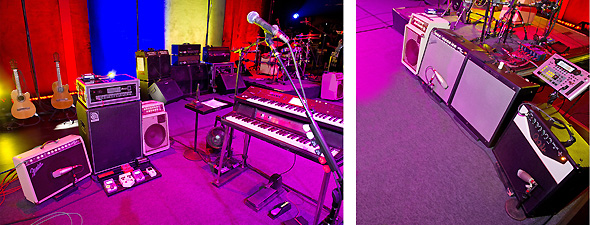
Beyond the i-3 stacks, the crew also tied into the house PA wherever it was feasible.
“That’s key to what we did each night,” Colby notes. “We used (Rational Acoustics) Smaart, time-aligned, and didn’t use any of the other systems’ EQ.
“We used our own Lake processing. If there was a center mono hang for the balcony, we used that, likewise bookshelf loudspeakers on the side. We added all of our own control to everything, and Rich walked the room with a wireless tablet during soundcheck to get things just right.”
The Nether Regions
The product of a consummate artist who enjoys modern technology but doesn’t necessarily use modern techniques, Buckingham’s snapshots as provided to Colby provided settings for EQ, dynamics, fader positions, VCAs, and more that served as templates from which refinements were made to optimize the tour’s sound.
Even if necessity banished his mix position into the nether regions of a room, Colby overcame the situation by using a pair of nearfield monitors set atop the doghouse of his console that brought the PA in close.
“The nearfields helped me keep things consistent,” he says. “With them I wasn’t turning the high-end up way out underneath the balcony – I had fantastic reference at low volume. After we tuned the system and Rich did all of the time alignment, I ‘noised’ the system, getting my target curve to look the same way it did the night before.
“Usually I didn’t have to change much on my desk. One night I may have moved the center frequency up slightly on the vocal, another I may have tucked it down a bit because of room acoustics or whatever.”

Colby has also introduced Buckingham to the modern joys of virtual sound checks. “This is another area where we evolved and learned together,” Colby says of the process. “It was something we consciously nurtured. Starting back in rehearsals, at night we would listen to what I recorded earlier in the day.
“Based upon input from Lindsey and the rest of the band as we listened, we’d try out different settings. Once everyone was happy, I’d recall the snapshot, make the move, and save it. Then it was onto the next song. The process continued on the road, and it just kept getting better and better.”
Changing Perception
Colby’s mix was “very” mono, with the exception of some overhead panning left and right, as well as some stereo sequenced passages. Drums weren’t panned as he normally would in larger rooms, and all of this was done, by his admission, as a way to maintain intelligibility in the smaller venues.
“The mix just had to have the right intelligibility,” he contends. “Lindsey’s music is complex lyrically, every song has a lot to say. The instrumentation is deep – he changes his guitar for every song. This show is a rainbow of colors. Because of the texture of its inputs, I had everything from vivid oranges to pretty pinks, nice blues, passionate purples, and blacker blacks.
“My goals were to create a good musical balance with excellent vocal intelligibility and low-end contour. Beyond that, it was probably even more vital that I strive to preserve the color of each voice and instrument. My collaboration with Lindsey has changed how I perceive many things. I know the next time I’m out with Juanes, what I’ve learned here will have me doing things a little differently.”
Gregory A. DeTogne is a writer and editor who has served the pro audio industry for the past 30 years. Photos by Steve Jennings.
